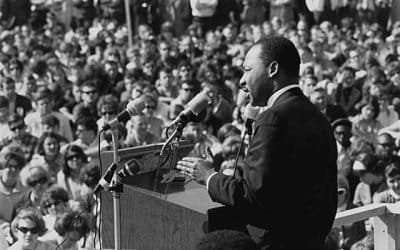President’s Day is the politically correct (and union-approved) way to celebrate the birthdays of George Washington and Abraham Lincoln, America’s two defining presidents in the pre-20th century era. But while both men deserve much of the accolades they receive, they are recognized primarily for their role as implementers, rather than as ideological leaders. There’s certainly nothing wrong with this. Washington served as an essential transitional figure, leading America from its monarchial past into its republican future. Lincoln reassembled the union after his immediate predecessors allowed it to decay into civil war.
But when we speak of ideological leadership, there are other presidents who don’t receive the automatic accolades of Washington and Lincoln. Two such men were the first father-son presidents, John Adams and John Quincy Adams. Neither men had enormously successful presidencies. Adams the elder is remembered largely for the Alien and Sedition Acts, the Patriot Act of its time, and Adams the younger found much of his one term tainted by the feeling of illegitimacy, having lost the popular vote decisively to Andrew Jackson only to be installed in office through the House of Representatives. But their failure to remain popular in office did not diminish the enormous importance of their intellectual contributions to America.
John Adams was perhaps our most critical founding father in the seminal days of 1776. It was Adams who led the pro-independence argument from the floor of the Continental Congress. Independence was by no means a united policy at the time. A powerful pacifist faction, led by Pennsylvania’s John Dickinson, pushed peace at all costs with Britain, even after the events of Bunker Hill, Lexington and Concord. As Adams pushed for a declaration of independence, Dickinson insisted on petitioning King George III for a peaceful solution. Initially, Congress adopted Dickinson’s approach, but when the insane Germanic monarch continued to turn a deaf ear, Adams seized the initiative and led the Congress’ push for independence. In the end, Thomas Jefferson would get much of the credit as the Declaration of Independence’s drafter, but it was Adams that did the heavy lifting to get to that point.
Another facet of Adams’ intellectual leadership was his ability, even in 1776, to see beyond the pending war. Adams was among the first of the founders to envision a national government for the colonies–not just a confederation of bickering states, but an individual rights republic. Adams was among the earliest advocates for the separation of powers and, perhaps most importantly, the independent judiciary. As president, Adams would help make that a reality by naming John Marshall as chief justice of the United States. Marshall would go on to assert the judiciary’s function as guardians of the Constitution, despite an early assault by men like Thomas Jefferson, who in practice did not approve of a strong court system.
While the elder Adams was the fighter, the younger John Quincy Adams gained early fame as a diplomat and secretary of state. But his intellectual leadership would truly come to fruition after leaving the presidency, and assuming a seat in the House of Representatives. It was there, during the 1830s and 1840s, where Quincy Adams became a moral leader of the abolitionist cause. Even in the face of constant Southern opposition to even discussing the slave question, Quincy Adams remained steadfast in arguing that the Declaration of Independence his father helped write applied to all Americans regardless of race.
In February 1841, at the age of 75, Quincy Adams capped off his career by presenting the closing arguments in the Amistad case before the U.S. Supreme Court. The Amistad was a Spanish vessel illegally trafficking in African slaves. The slaves ended up seizing control of the vessel by force, after which the ship found its way to Long Island Sound. A coast guard ship claimed the Amistad and the slaves under salvage laws, and a two-year legal fight ensued over the fate of the Africans. After two lower court victories for the Africans, the administration of President Martin Van Buren insisted on appealing to the Supreme Court. Roger Baldwin, a future Connecticut governor and the Africans’ lawyer, enlisted Quincy Adams to help present the case to the high court.
In those days, Supreme Court arguments lasted for hours if not days. The Amistad case itself required four days of arguments, with Quincy Adams presenting the most riveting of the oratory. In his presentation, Adams did not just confine himself to the narrow legal question–whether the U.S. had a duty to return the Africans to the queen of Spain as Spanish property–but he expounded on the intellectual and moral justifications against slavery. Adams ridiculed Van Buren for sacrificing the freedom of the Africans to appease the Spanish crown. He argued the case from every angle, including the Bible, the Declaration of Independence, and ultimately the fundamental tenets of natural law and reason.
In the end, Adams would prevail, at least on the narrow legal question. Justice Joseph Story, writing for the Court, said that human beings could not implicitly be categorized as property, and thus America’s treaty with Spain governing salvage did not require the return of the Africans (who, it should be noted, were taken from their homes long after Spain officially banned the slave trade.) The Amistad decision was one of the first official recognitions that the very concept of treating individuals as property was contrary to the genuine founding principles of America. It would take 25 more years–and a near-fatal reversal by the Supreme Court in Dred Scott–but thanks to the efforts of men like Adams, the intellectual course of the nation on the slave question was irrevocably set.
Nearly two centuries later, neither John Adams or John Quincy Adams get the popular accolades reserved for Washington, Lincoln, or even the contemporary presidents, most of whom are little more than champions of the mixed economy. After all, when John Adams spoke on the floor of Congress in 1776, his ideological motivation was not “compassionate conservatism.” And when his son took to the Supreme Court’s well in 1841, he did not talk of how we could give the Africans prescription drug coverage. Both men spoke of freedom, liberty, and individual rights. They did so both as practical men who understood what their noble goals would require, and as romantic idealists, committed to leading a society of men bound only by reason.



